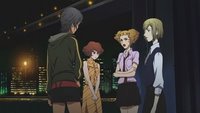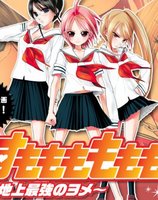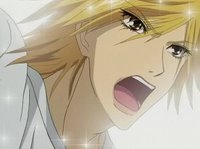Lovely Idol
 With a title like “Lovely Idol,” there isn’t much room for doubt about the contents of this show. The character designs are appropriately ultra-moe, and reasonably animated. The voice actresses are treacly. And there’s lots and lots of idol music; literally about a quarter of the first episode is musical interlude, and most of that comes before the main characters have even been introduced. If you like this sort of thing, go for it.
With a title like “Lovely Idol,” there isn’t much room for doubt about the contents of this show. The character designs are appropriately ultra-moe, and reasonably animated. The voice actresses are treacly. And there’s lots and lots of idol music; literally about a quarter of the first episode is musical interlude, and most of that comes before the main characters have even been introduced. If you like this sort of thing, go for it.Watching?: no.
Negima!? Magister Negi Magi
 Negima’s original author, Ken Akamatsu, is one of the biggest names in modern manga. So, it’s one of the great mysteries of anime that the TV adaptations of Akamatsu’s works have been so uniformly inadequate. Looking at the 2005 version of Negima, for instance, one is struck by the low-rent animation, limp OP, and most critically, the insertion of god-awful Wacky Highjinks in place of anything that might have been funny or charming or slightly naughty in the manga.
Negima’s original author, Ken Akamatsu, is one of the biggest names in modern manga. So, it’s one of the great mysteries of anime that the TV adaptations of Akamatsu’s works have been so uniformly inadequate. Looking at the 2005 version of Negima, for instance, one is struck by the low-rent animation, limp OP, and most critically, the insertion of god-awful Wacky Highjinks in place of anything that might have been funny or charming or slightly naughty in the manga.In general, Negima!? is a step up from the 2005 version: the usual problems are still there, but they’re not quite as serious. The animators have cleverly decided to pretend that the earlier series was never made, and start over with boy wizard Negi’s (image, center) arrival in Japan, and first day at his new job teaching middle school. The characters look odd in stills, but when animated manage to sustain a certain resemblance to Akamatsu art, if you squint. I’ll stick with the manga, thanks.
Watching?: probably not.
Otome wa Boku ni Koi Shiteru (That Maiden Loves Me [with “me” written as “older sister”])
 High-powered interpersonal politics and convoluted yuri (girl’s love) relationships are de rigueur for anime set at the (purely imaginary?) elite parochial boarding schools of Japan. Modern examples of the genre, probably taking their cues from Shoujo Kakumei Utena, have much of the external form of shoujo anime, while also being tailored, in whole or in part, to a male audience.
High-powered interpersonal politics and convoluted yuri (girl’s love) relationships are de rigueur for anime set at the (purely imaginary?) elite parochial boarding schools of Japan. Modern examples of the genre, probably taking their cues from Shoujo Kakumei Utena, have much of the external form of shoujo anime, while also being tailored, in whole or in part, to a male audience.“Oto-Boku” is this fall’s closest approach to the girl’s school yuri genre, though it contains certain heretical elements. First and foremost, the possibilities for yuri frisson are much reduced by the fact that the main character, Mizuho (image, left), is really a boy disguised as a girl. As an aside, I have discovered that you can get a fairly gratifying reaction out of figure-collecting friends, who have bought Mizuho models solely on the basis of cute design, by informing them of this plot twist. The tone is relatively light, and the fanservice, while thin on the ground, is more of the prancing-around-in-sheer-negligee-type, as opposed to the traditional blushing-during-awkward-silence-type.
Watching?: maybe.
Pumpkin Scissors
 Not that the title provides any indication, but this is a military action show set in an alternate post-World War I Europe. Alice is the enthusiastic young lieutenant leading Pumpkin Scissors, a war relief unit. She takes in Oland (image), a shell-shocked gentle giant who was formerly part of a shadowy and much-feared group of tank-killers. Alice, Oland, and comrades are under-funded and ill prepared for the work, but they set out to right wrongs and protect the weak in the lawless, burned out mess of a world that the war has left behind.
Not that the title provides any indication, but this is a military action show set in an alternate post-World War I Europe. Alice is the enthusiastic young lieutenant leading Pumpkin Scissors, a war relief unit. She takes in Oland (image), a shell-shocked gentle giant who was formerly part of a shadowy and much-feared group of tank-killers. Alice, Oland, and comrades are under-funded and ill prepared for the work, but they set out to right wrongs and protect the weak in the lawless, burned out mess of a world that the war has left behind.With a grittier atmosphere and more visual inventiveness, Pumpkin Scissors would have been an easy recommendation. As it is, the animation is kind of flat, and the mood is cheerier than it has any right to be. Oland’s corpse-candle lantern, which he unshutters when it’s time for some evildoer to get blasted to hamburger, is a memorable touch, at least.
Watching?: maybe.
Red Garden
 Set in New York City, or a close Studio Gonzo approximation thereof, Red Garden starts with the mysterious death of a highschool student, and follows four classmates who have lost their memories of the fatal night. Our heroines start to see butterflies that are invisible to everyone else, and are led to a woman who informs them that they have been drafted as werewolf hunters.
Set in New York City, or a close Studio Gonzo approximation thereof, Red Garden starts with the mysterious death of a highschool student, and follows four classmates who have lost their memories of the fatal night. Our heroines start to see butterflies that are invisible to everyone else, and are led to a woman who informs them that they have been drafted as werewolf hunters.Based on past Gonzo experience, I fear that Red Garden is going to devolve into a cheesily-animated sequence of meandering, pointless storylines and grotesque bloodbaths. In a less-crowded season I might stick around to see if it goes anywhere, but there are too many superior viewing possibilities out there right now.
Watching?: no.
SumomomoMomomo: Chijou Saikyou no Yome
(Both Sumomo and Momo: The Strongest Bride on Earth)
(Both Sumomo and Momo: The Strongest Bride on Earth)
 Momoko (image, center) is the heir to a family of ninjas, and engaged to marry Koushi, also of ninja extraction. Momoko’s father has decided that a woman can’t take over his school of martial arts, and that the best option for preserving the family legacy is for Momoko to produce a son, as soon as possible. Appallingly, Momoko agrees, and starts trying to seduce Koushi. The running joke here is that Momoko is actually very powerful, while fiancée Koushi thinks only of his dream of becoming a lawyer. Handled with great skill, this premise might be pretty funny, but handled poorly, as it looks like it is being handled, it will get annoying very quickly.
Momoko (image, center) is the heir to a family of ninjas, and engaged to marry Koushi, also of ninja extraction. Momoko’s father has decided that a woman can’t take over his school of martial arts, and that the best option for preserving the family legacy is for Momoko to produce a son, as soon as possible. Appallingly, Momoko agrees, and starts trying to seduce Koushi. The running joke here is that Momoko is actually very powerful, while fiancée Koushi thinks only of his dream of becoming a lawyer. Handled with great skill, this premise might be pretty funny, but handled poorly, as it looks like it is being handled, it will get annoying very quickly.Watching?: no.
Super Robot Taisen OG: Divine Wars (Super Robot Wars OG: Divine Wars)
 Back in the heyday of the Sega Saturn, I spent many a late night playing the Super Robot Taisen games. The games’ strategic play was addictive, but the real attractions were the robots: a buffet of justice-dispensing mechanical demigods, taken from most of the major robot anime up to that point, awaiting my commands. Add to that cutscenes of beloved characters from the various shows—picture Bright Noah and Gendou Ikari bitching at each other about how they’re going to fight the final battle with Dr. Hell—and you’re in robot fanboy Valhalla.
Back in the heyday of the Sega Saturn, I spent many a late night playing the Super Robot Taisen games. The games’ strategic play was addictive, but the real attractions were the robots: a buffet of justice-dispensing mechanical demigods, taken from most of the major robot anime up to that point, awaiting my commands. Add to that cutscenes of beloved characters from the various shows—picture Bright Noah and Gendou Ikari bitching at each other about how they’re going to fight the final battle with Dr. Hell—and you’re in robot fanboy Valhalla.Anyhow, there will be absolutely nothing like that in Super Robo OG, because the OG stands for Original Generation, meaning all-new, non-anime, game-original characters and robots. Unless you’re a fan of the recent OG games, I can’t imagine any reason to subject yourself to this show.
Watching?: not unless someone pays me, which seems unlikely.
Tokimeki Memorial: Only Love
 Coincidentally, the other videogame that laid waste to vast chunks of my youth in the mid to late ‘90s was Tokimeki Memorial, one of the first bishoujo games, and an important source for the conventions of modern bishoujo games and anime. Tokimemo: Only Love is based on a recent sequel, Tokimemo Online, with which I am unfamiliar, but which sounds intriguing. How exactly does an online dating-sim work? Do players from all over Japan compete for the affections of the virtual young women? Or do some play as the girls (as the website tagline “boys & girls school community game” would seem to indicate)? The mind boggles.
Coincidentally, the other videogame that laid waste to vast chunks of my youth in the mid to late ‘90s was Tokimeki Memorial, one of the first bishoujo games, and an important source for the conventions of modern bishoujo games and anime. Tokimemo: Only Love is based on a recent sequel, Tokimemo Online, with which I am unfamiliar, but which sounds intriguing. How exactly does an online dating-sim work? Do players from all over Japan compete for the affections of the virtual young women? Or do some play as the girls (as the website tagline “boys & girls school community game” would seem to indicate)? The mind boggles.In Only Love, Riku is the name given to the Hero, with Sayuri (image) playing the role of Shiori-tan. Kirameki High alumni such as myself will be amused to see old game standbys like the dorky friend of the hero who keeps track of biographical information on the girls; the uninitiated will probably find these touches distracting. I can’t say I much care for Only Love’s comic moments, which run towards the frantic, as opposed the low-key, distinctively strange sense of humor I recall from the 1990s games.
Watching?: yes, but mostly for nostalgia value.
Tenpo Ibun Ayakashi Ayashi [~translation beyond me~]
 It’s 1800’s Japan, and refugees, fleeing from starvation and monsters in the countryside, are overrunning Edo. Yukiatsu, a warrior with a connection to the red-lit Other World of the demons, is laying low among the refugees, but is forced to come out of hiding in order to protect a mother and child.
It’s 1800’s Japan, and refugees, fleeing from starvation and monsters in the countryside, are overrunning Edo. Yukiatsu, a warrior with a connection to the red-lit Other World of the demons, is laying low among the refugees, but is forced to come out of hiding in order to protect a mother and child.Ayakashi Ayashi is the latest from studio Bones, so you can be sure it will be a solid production, with some interesting visual elements, such as the portrayal of the Other World as an animated silk painting. Samurai drama/action is not really my thing, but fans of the genre will probably do well to look into this one.
Watching?: probably not.
Yamato Nadeshiko Shichi Henge (Seven Apparitions of the Traditional Japanese Beauty)
 Four handsome but impoverished boarders at a fabulous mansion are challenged by their landlord to transform the heroine, Sunako, into a true lady. There are complications, of course: Sunako looks and acts like one of the pale, stringy-haired ghouls from Ju-on (The Grudge). Wackiness ensues.
Four handsome but impoverished boarders at a fabulous mansion are challenged by their landlord to transform the heroine, Sunako, into a true lady. There are complications, of course: Sunako looks and acts like one of the pale, stringy-haired ghouls from Ju-on (The Grudge). Wackiness ensues.Yamato Nadeshiko is basically a harem show for girls, and is burdened by the same canalization of story and character that affects all harem shows. It might still have been a lot of fun, though, even for male viewers (cf. Ouran Host Club). The whole J-horror parody aspect, for instance, has proven to be a rich source of laughs for other anime (cf. Muteki Kanban Musume). It just doesn’t click here, at least in part because of what looks to be a pathetically low budget.
Watching?: no.
Yoake Mae Yori Ruriiro na Crescent Love (Brighter than the Dawning Blue: Crescent Love)
 Yoake Mae…etc. begins with a flashback to a devastating space war between Earth and her Lunar colonies, portrayed in stylin’ Gunbuster-esque black and white. The plot picks up many years after the war, when Earth civilization has rebuilt itself exactly to the level of early 21st century Japan. And then all of this backstory becomes irrelevant, as Moon princess Feena (image, right) moves in with ordinary Earth boy Tatsuya (image, left) as a homestay student, and Yoake Mae turns into a fair-to-middling harem show (of the male oriented variety). Among various issues that plague this show: the intricate, game-derived character designs are nice in theory, but were apparently more than the animators could handle on a consistent basis.
Yoake Mae…etc. begins with a flashback to a devastating space war between Earth and her Lunar colonies, portrayed in stylin’ Gunbuster-esque black and white. The plot picks up many years after the war, when Earth civilization has rebuilt itself exactly to the level of early 21st century Japan. And then all of this backstory becomes irrelevant, as Moon princess Feena (image, right) moves in with ordinary Earth boy Tatsuya (image, left) as a homestay student, and Yoake Mae turns into a fair-to-middling harem show (of the male oriented variety). Among various issues that plague this show: the intricate, game-derived character designs are nice in theory, but were apparently more than the animators could handle on a consistent basis.Watching?: probably not.
--
And that’s another 20% of the latest TV anime. For various reasons, I’ve missed a few things that I meant to cover, like Kujibiki Unbalance (the DVD release of which will include bonus Genshiken episodes!), Happiness, and Black Blood Brothers. Overall, while there probably isn't anything in the S-ranked, Instant Classic category this fall, there are plenty of potential entertainments. Death Note and Kanon are the best and most obvious examples, but there are others, as well as plenty of guilty pleasures.




3 comments:
Yay! Got here first! Now where's my PS3?????
So of all the new shows out there, only two are currently must watch. I guess that's okay since it makes it a little easier to focus on enjoying a particular series more.
Having seen the first ep of Kanon, I would have never guessed that a demon hunter would be part of the cast. Not being too familiar with that game/anime, I was guessing that it was some sort of sweet and subtle depiction of returning to life in a small town.
I agree with everything you said about the Negima series, both the old and new one. It puzzles me how a series consisting of nothing but a series of mindless and extremely unfunny slapstick could become so popular. Any plot developments were far and few in between, and there are way too many (female)characters with whom to emphatize, much less keep track and/or remember.
Also, the Asatte no Houkou series does seem to be slow and a little bit ponderous. Actually, just slow right now. I like the premise though as well as the character designs, so I hope the series doesn't crumble under much like the .... umm .... Patlabor 2 movie did. Wow! I had to reach way back to find an analogy!
Finally, That's a pretty cool name for your blog!
Thanks, Anonymous! Don't hold me to this, but I imagine that if you stop by your local Toys 'R' Us on the launch date, and tell them that Matt said you could take a PS3, they'll give you one.
-M.
Will do, DSterner! Nice to see that your site is coming along!
Post a Comment